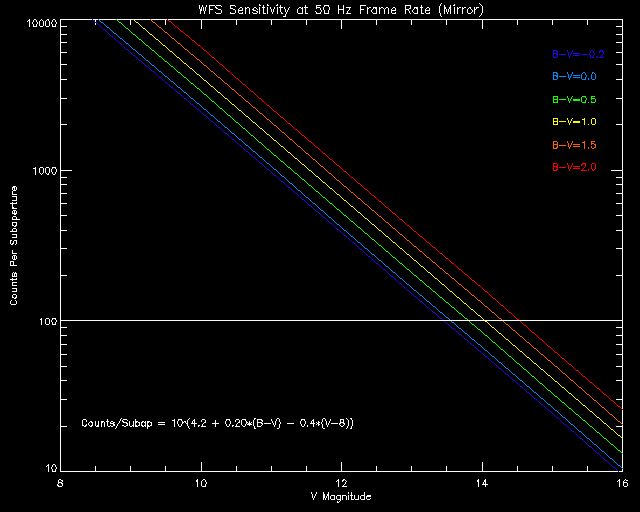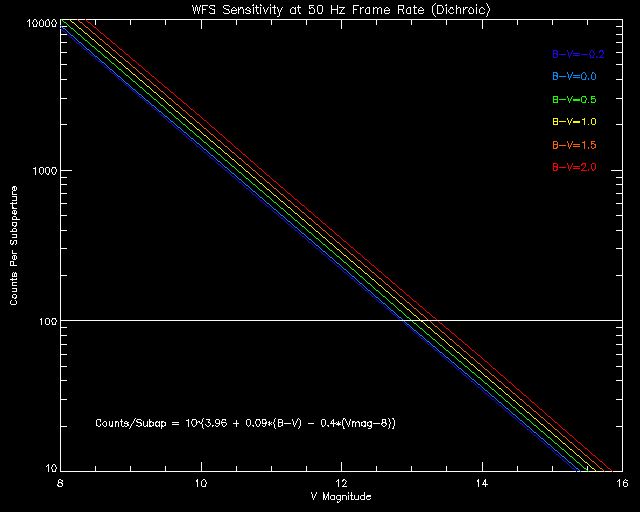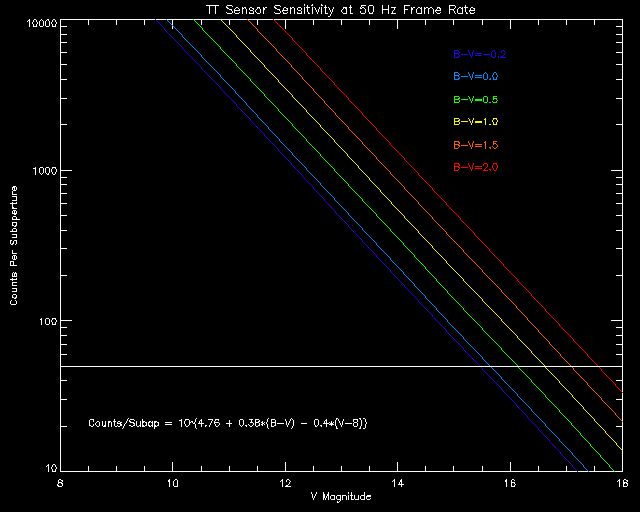Observing Information
Introduction to AO Observations
AO Run Planning
FAA and US Space Command Restrictions
AO Performance
Wavefront Sensor and Tip/Tilt Camera Sensitivity
Sky Coverage
IRCAL Sensitivity
AO Tutorials
NGS mode requires a natural guide star brighter than 13th
magnitude under normal conditions, within 55" of
the science target. See WFS Sensitivity for
more details.
LGS mode requires a natural guide star brighter than 16th magnitude
for tip/tilt correction, within 55" of the science target (see Tip/Tilt Camera Sensitivity for more details. Laser
operations are also restricted by FAA rules to elevations greater than
45 degrees and times from 11pm to 5am. LGS science targets must also
be cleared by US Space Command in advance(see FAA and US
Space Command Restrictions for more details).
The AO system feeds IRCAL, an
AO-optimized IR camera that uses a 256x256 Rockwell PICNIC array which
is sensitive from 0.9 - 2.5 microns and provides Nyquist sampled
imaging at 2.2 microns (0.076 arcsec/pix). The internal image quality
is excellent over the entire 19.4 arcsecond field of view. IRCAL is
equipped with standard near-IR photometric filters and some
narrow-band filters. User supplied filters can be installed in a warm
external filter wheel. IRCAL also has grisms for medium resolution
(R=500) H and K spectroscopy. It is strongly recommended to refer to
the IRCAL manual in addition
to the IRCAL Sensitivity Plots below before
applying for 3-m time and planning your observations.
Most important to planning AO observations is determining what quality data
are necessary to get the desired science results.
Issues to discuss?
LGS mode observing does have restrictions because the moderate powered
sodium laser used to create the guide star is a hazard to pilot's (and
passenger's) eyes and sensitive cameras on satellites. To minimize
the risk to pilots, the laser is only operated from 11pm to 5am when
the traffic at the local airports is light. In addition, the laser is
propagated at a maximum zenith distance of 45 degrees. To ensure that
aircraft are not illuminated with the laser, we have a boresighted radar
system that, when triggered, closes a fast shutter to cease laser propagation.
We also employ plane spotters who sit outside the 3-m telescope dome. These
spotters have headsets so they can communicate with the laser operator in the
3-m control room in case a plane approaches the laser and also have kill
switches to shut down the laser in case a plane is approaching the beam
to quickly for a more controlled shut down by the laser operator.
To protect astronauts and satellites from harm, all targets to be
observed with the laser must be cleared in advance by US Space Command
at Cheyenne Mountain in Colorado. Currently the avoidance cone
diameter for Lick Observatory LGS targets is 10 arcminutes. This leads to
few satellite shutdowns of the laser.
see ??? for instructions on how to submit LGS targets lists, etc..
Introduction to AO Observations
Adaptive Optics (AO) is used to correct atmospheric blurring of images in real
time to create near-diffraction limited images. The Lick AO system is used
at the Cassegrain focus of the Shane 3-m Telecope. It can be used in either
natural guide star (NGS) or laser guide star (LGS) mode. Under good conditions
the AO system routinely reaches the diffraction limit (0.15 arcsec) at
2.2 microns.
AO Run Planning
Section under construction - please forgive the
disorganization/lack of information You may also want to refer
to Preparing for an AO Run.
1) Science targets: Do they have acceptable guide stars within 55
arcsec of the scence target?
2) Can the predicted Strehl under good conditions from guide star
magnitude give you the necessary science results?
3) What is the backup plan for poor conditions?
4) Is it an NGS or LGS starget?
5) AO observations are best during periods of good seeing. In general,
the best seeing occurs in the late summer and early fall.
6) Schedule observations so that your science targets are as close as
possible to zenith during exposures. Less airmass means less
turbulence.
7) Observed isoplanatic angles at Lick range from 15 arcsec to 40
arcsec (as measured with the near infrared camera. The isokinetic
angle for laser observations is typically 60 arcseconds.
8) An AO system typically produced a point spread function (PSF)
consisting of a diffraction-limited core plus a diffuse halo. The
halo is typically the same size as the seeing disk, but contains much
less light than it would in the absence of AO. For quantitative
imaging, photometry, and spectroscopy is is usually necessary to
observe a PSF star before and/or after observing the science
object. You should select PSF reference stars to have the same
magnitude, color, and elevation angle as the science object's guide
star so that AO system conditions duplicate, as nearly as possible,
the conditions during science object exposure.
FAA and US Space Command Restrictions
There are no restrictions for NGS observing from the FAA or US Space
Command.
AO Performance
Performance of the AO system depends on both the magnitude of the
guide guide star and the seeing conditions. The below plots show what Strehl
one can expect for different magnitude guide stars and under different
seeing conditions in NGS mode.
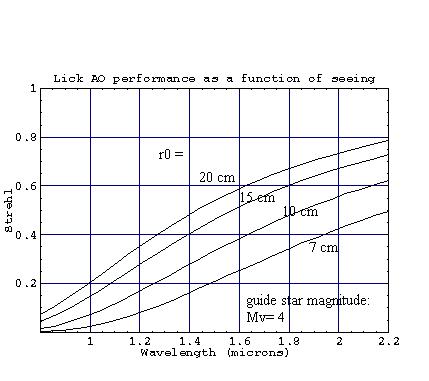
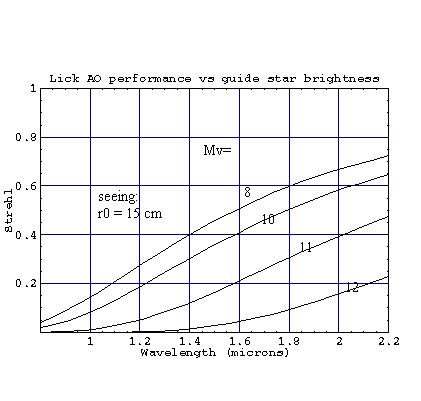
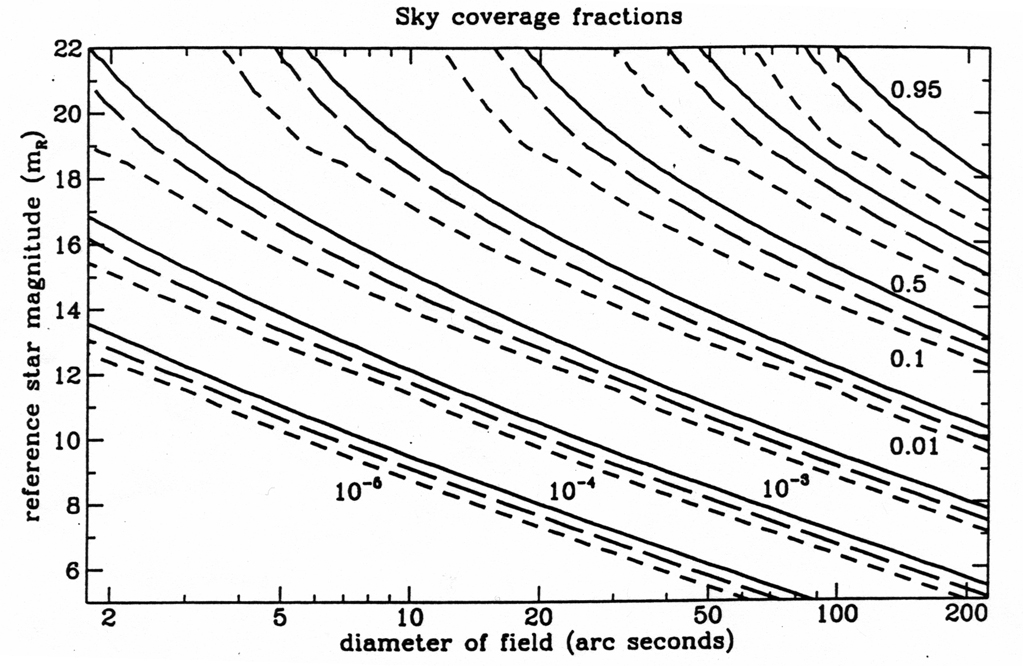 |
Density of natural guide stars at various
Galactic Latitudes: |
IRCAL Sensitivity
Below are plots depicting the sensitivity of the IRCAL camera for both
point sources and extended sources. For more information about the IRCAL
camera, see the IRCAL manual.


AO Tutorials
Novice AO users may find it useful to refer to the following web sites for
basic general information about adaptive optics.
Elinor Gates Last modified: Mon Apr 28 18:06:37 PDT 2008
